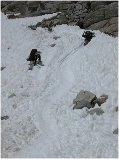Hiking in the Snow on the Pacific Crest Trail
Unlike on the Appalachian Trail, a Pacific Crest Trail (PCT) hiker is often forced to hike in the snow. The most snowy mountain passes are in the ‘High Sierra’, however a thru-hiker can expect more snow fields in the northern Cascades.
The general consensus amongst PCT (and John Muir Trail) hikers is to clear one snowy pass per day. The best time to do that is usually in the late morning, allowing the early morning ice and crust to melt. Then, the hike is descending the pass in the early afternoon, before it becomes too mushy and mashed potatoes-like, thus avoiding postholing (sinking through the snow up to your thighs).
However, descending can become quite laborious–perhaps even more so than ascending. The hiker is forced to be ever-vigilant about slipping and going into a free fall. This can be quite taxing on the quads. Thus, the temptation is to glissade. This refers to the hiker practice of sliding in controlled fashion down a mountain pass. It only works well in certain situation, and you must be very careful. Injuries are not infrequent.
In this photo, CanaDoug (Doug from Canada) has decided to glissade down Forrester’s Pass, while I am trying to sidestep down. This attempt at caution drew derision from my fellow hikers. I had read Yogi’s PCT Handbook, in which she warned of the dangers of glissading. But finally in the Sierras, it became so clear that there were so many snowy mountain passes that I was going to have to learn a controlled glissade. It wasn’t always pretty, but even a 7-foot tall southerener was able to pull it off!
Bill Walker is the author of Skywalker–Highs and Lows on the Pacific Crest Trail (2010). He is also the author of Skywalker–Close Encounters on the Appalachian Trail (2008), as well as ‘The Best Way–El Camino de Santiago (2012).











Follow Us!